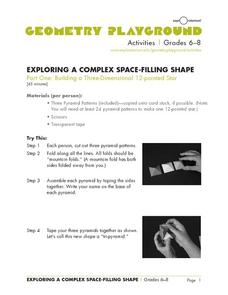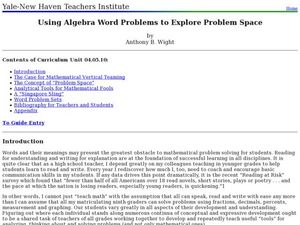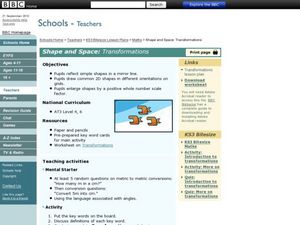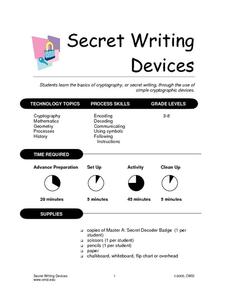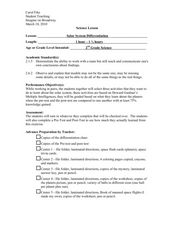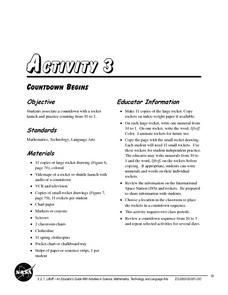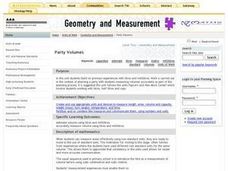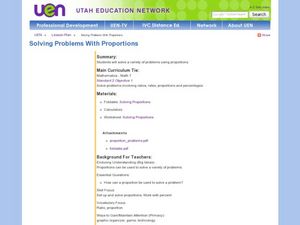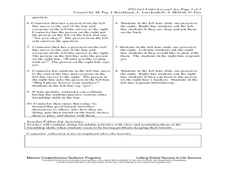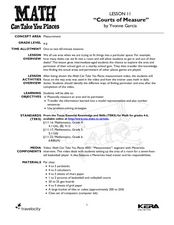Exploratorium
Exploring a Complex Space-Filling Shape
Middle schoolers build a three-dimensional 12-pointed star as a geometric exercise. The shape is quite-difficult to construct. Luckily there is an excellent template that learners cut out, then use to make their pyramid. The second part...
PHET
Earth’s Magnetic Field from Space
Feel the pull of science! The final installment of this 18-part series is an application of everything learned in the previous high school lessons. Scholars are given a magnetic field map and must propose an arrangement of magnets that...
Curated OER
Geometry In Space
Students Fulfill the requirements of Texas Standards as it relates to math and science. In this circle lesson, students identify the arcs and angles of a circle as it relates to Pi. They solve real life scenarios using space as an example.
Curated OER
Using Algebra to Explore Problem Space
Students apply their knowledge of math by rewriting word problems using equations. In this word problem lesson, students build upon previous knowledge as they set up the correct steps to solve word problems. This lesson is full of hints...
Curated OER
Shape and Space: Transformations
Students explore transformations. In this mathematical transformations lesson, students define quadrilaterals, convert centimeters to meters, and complete a transformations worksheet.
Captain Planet Foundation
Shape Shifters in the Math Garden
Combines mathematical measurement with gardening skills. Third graders hunt for worms in the garden and try to find the longest one. They also measure and weigh vegetables that they harvest from the garden, measure rainfall amounts,...
Curated OER
Secret Writing Devices
Elementary and middle schoolers explore the world of secret writing, otherwise known as cryptography. After an interesting introduction to the activity, learners utilize a decoder badge which uses the St. Cyr cipher - which is a cipher...
Curated OER
Do You Feel Lucky?
Students explore probability by using games based on probable outcomes of events. They name all of the possible outcomes of an event and express the likelihood of such an event occurring.
Curated OER
LESS THAN ZERO
Upper graders study how to extend a vertical number line to include negative numbers; order numbers on the number line; and find the distance between numbers on a number line. They will begin with a game using dice to explore...
Curated OER
What's in a Shape?
Students explore characteristics of shapes by making and using tangram sets. They discover how the tangram pieces are related to one another, and determine how many different combinations of the triangles, squares, and parallelograms in...
Curated OER
Using Algebra
Sixth graders explore mathematics by completing equations in a math notebook. They will collaborate in small groups to complete different algebra problems and write their work down in a notebook, which they show their teacher. Then they...
Curated OER
Mandalas, Polygons and Symmetry
Students create a geometric pattern using mandalas, polygons and symmetry. In this geometry lesson, students analyze the mathematics involved in making the mandalas, including the shapes and symmetry. Students create their own mandalas...
Curated OER
Beads, Balls, and Beakers
Students analyze the amount of space required to pack round objects. In this geometry lesson, students practice using space economically by practicing packing spheres into beakers. They then translate this concept to molecules being...
Curated OER
Solar System Differentiation
Students explore the solar system. In this solar system science lesson plan, students choose 3 out of 12 centers to visit, each of which contains an activity related to the planets. The station activities are designed to address...
Curated OER
How Probable is It?
Students explore probability. For this probability lesson, students look at videos and websites where they discover probability facts that can be used in situations. They determine the probability of different events.
Curated OER
Getting to the Point
Students determine location by using the technique of triangulation. They imagine that they are out in the wilderness and have come to the top of a ridge. How can one identify the ridge on the topo map? How can one figure out where you...
Curated OER
Countdown Begins
Students explore the countdown sequence for a rocket launch. They watch a video of a rocket launch, discuss the significance of the countdown sequence, and place ten paper rockets in the proper sequence.
Curated OER
Party Volumes: Measurement
Second graders explore liters and milliliters. They estimate volume and accurately measure the volume. Students plan a party and measure volume using liters and milliliters as part of the planning process.
Curated OER
Solving Problems with Proportions
Seventh graders explore the concept of proportions. In this proportion lesson, 7th graders play a review game involving whiteboards. Students work in groups to solve a given proportion the fastest. Students also work in pairs to solve...
Curated OER
Can You Find Me Now?
Students locate points using longitude and latitude coordinates. They locate their home using longitude and latitude, explore the uses of GPS, and accurately use a GPS.
Curated OER
Friendship Line Dancing
First graders explore the characteristics of being a good friend. They observe a puppet and discuss why the puppet is sad. In groups, 1st graders form two lines, facing each other. They practice talking to each person in the line,...
Curated OER
Courts of Measure
Students practice their area and perimeter measurement. For this measurement lesson, students watch a video about perimeter and area. Students measure a gym for perimeter and area. Students write number sentences for the area and...
Curated OER
The Power of Compounding
Sixth graders examine the concept of compounding interest on invested money. They explore how much interest their money would earn through compounded interest. Students conclude that they should invest early and often.
Curated OER
Brainstorming and Number Patterns
Ninth graders discover what it means to "brainstorm." They explore a given simple number pattern and then, working in groups, brainstorm more complicated number patterns. They display them around the room and then solve the number...
